Rural Prosperity
Jal Jeevan Mission
With ₹2.08 Lakh Crore central outlay, Delivering Tap Water to Over 15.72 Crore Rural Households
Posted On:
26 OCT 2025 10:26AM
|
Key Takeaways
- Over 15.72 crore rural households now have access to safe tap water.
- At the launch of Mission (2019), only 3.23 crore households had access to tap water. Since then, 12.48 crore additional households connected, marking one of India’s fastest infrastructure expansions.
- The Mission has potential to generate 3 crore person-years of employment during its build-out, with nearly 25lakh women trained to use Field Testing Kits.
- WHO estimates that provisioning of safely managed drinking water in the country would result in averting 4 lakh diarrheal death. It is also estimated that with universal coverage of safely managed drinking water in the country, almost 14 million DALYs (Disability-Adjusted Life Year) are to be averted.
- WHO also asserts that providing tap connection to every rural household would result in significant time saved on water collection (5.5 crore hours each day), especially among women (three quarter of this burden).
- 2,843 water testing laboratories across India tested 38.78 lakh samples in 2025–26, ensuring stringent water quality monitoring.
|
Introduction
India has achieved a major milestone under the Jal Jeevan Mission (Har Ghar Jal), with over 81 per cent of rural households now having access to clean tap water. As of 22 October 2025, more than 15.72 crore rural homes are receiving safe drinking water through household taps, marking a significant step towards universal water security in rural India. Under the Mission, the Government approved support to States and Union Territories with a central outlay of ₹2,08,652 crores, which has been largely utilised.
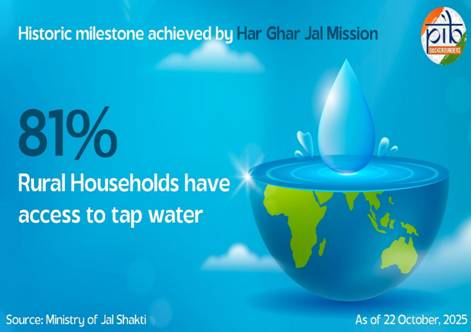
The Mission was launched by Prime Minister Narendra Modi on 15 August 2019 with the vision of providing tap water to every rural household. At that time, only 3.23 crore households (16.71 per cent) had access to tap water. Since then, 12.48 crore additional households have been connected, marking one of the fastest expansions of basic infrastructure in rural India.
Jal Jeevan Mission also strives to free mothers and sisters from the centuries-old drudgery of fetching water for their households. It aims to improve their health, education, and socio-economic conditions, bringing ease of living and adding pride and dignity to rural families.
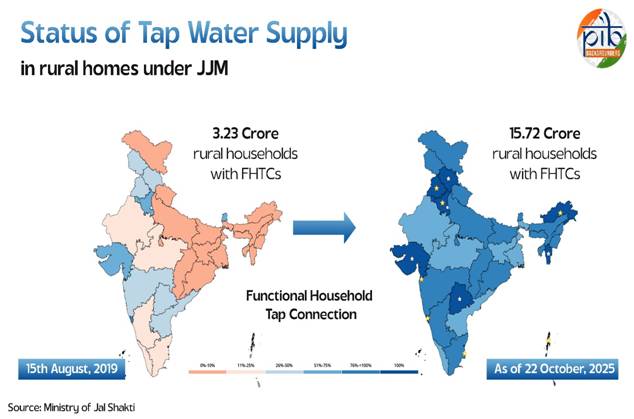
The Mission gives equal emphasis to sustainability and community participation. It includes source sustainability measures such as recharge and reuse through greywater management, water conservation, and rainwater harvesting. It is implemented through a community-based approach, with Information, Education and Communication (IEC) activities as key components to create awareness and ownership. The Mission seeks to build a jan andolan (people’s movement) for water, making it a shared national priority.
Objectives
The broad objectives of the Jal Jeevan Mission include:
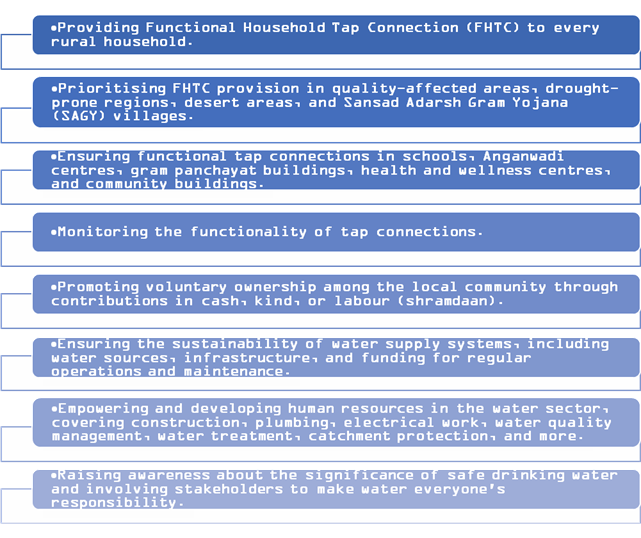
Progress Under the Jal Jeevan Mission (as of 22 October, 2025)
The Jal Jeevan Mission continues to make steady progress towards ensuring safe and adequate drinking water for every rural household in India.
- District-Level Progress: Tap water has reached all households, schools, and Anganwadi centres in 192 districts, of which 116 districts have been officially certified through Gram Sabha resolutions after verification.
- Block, Panchayat, and Village Coverage:
- Blocks: 1,912 have reported full coverage, with 1,019 certified.
- Gram Panchayats: 1,25,185 have reported, and 88,875 have achieved certification.
- Villages: 2,66,273 have reported, with 1,74,348 certified under the Har Ghar Jal initiative.
- States/UTs with 100% Coverage: Eleven States and Union Territories, Goa, Andaman & Nicobar Islands, Dadra & Nagar Haveli & Daman & Diu, Haryana, Telangana, Puducherry, Gujarat, Himachal Pradesh, Punjab, Mizoram, and Arunachal Pradesh, have achieved full tap water connectivity for all rural households.
- Institutional Coverage: Tap water supply has been ensured in 9,23,297 schools and 9,66,876 Anganwadi centres across the country.
'Reported' means water supply department of State/ UT has confirmed that water is being supplied through taps to all households, schools and Anganwadi Centers in that administrative unit.
'Certified' means that the Gram Sabha has passed the resolution after ascertaining the claim of water supply department that all the households, schools and Anganwadi Centers are getting the tap water supply in village. This is carried out after the water supply department provided the certificate to Gram Panchayat declaring that all households are provided with tap water supply.(
Quality Assurance and Monitoring
Under the Jal Jeevan Mission, a robust system for quality assurance and monitoring has been implemented to ensure safe drinking water in rural areas. During 2025–26 (as on 21 October 2025), a total of 2,843 laboratories (2,184 institutional and 659 WTP-based) tested 38.78 lakh water samples across 4,49,961 villages in the country.
To promote community-level participation, 24.80 lakh women have been trained to test water quality using Field Testing Kits (FTKs) in 5.07 lakh villages. This community-driven approach ensures early detection of water contamination and strengthens local ownership of rural water quality monitoring.
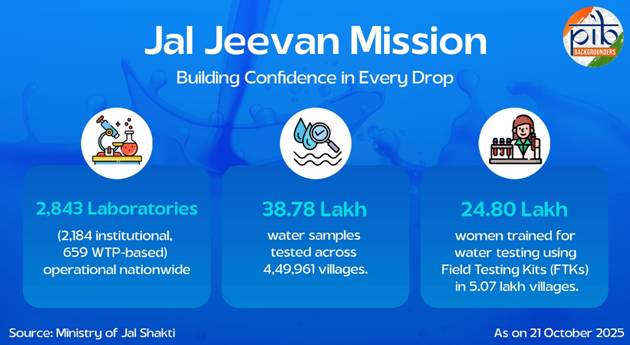
Key Components of the Jal Jeevan Mission (JJM)
To achieve the objectives of the Jal Jeevan Mission, the following components have been envisaged:
- In-Village Piped Water Supply Infrastructure – Development of piped water systems within villages to ensure tap water connections to every rural household.
|
- Sustainable Drinking Water Sources – Development of reliable drinking water sources and/ or augmentation of existing sources to provide long-term sustainability to water supply system.
|
- Bulk Water Transfer and Distribution – Establishment of bulk water transfer systems, treatment plants, and distribution networks.
|
- Technological Interventions for Water Quality – Implementation of technologies to remove contaminants where water quality is an issue.
|
- Retrofitting of Existing Schemes – Upgrading completed and ongoing schemes to provide Functional Household Tap Connections (FHTCs) at a minimum service level of 55 litres per capita per day (lpcd).
|
- Grey Water Management – Treatment and reuse of grey water to promote water conservation.
|
- Community Capacity Building – Support activities aimed at building the capacities of communities for sustainable water management.
|
- Contingency Funds – Provision of funds to address unforeseen challenges or issues arising from natural disasters or calamities.
|
Transforming Rural Water Supply through Digital Innovation
The Department of Drinking Water and Sanitation (DDWS), Ministry of Jal Shakti, the upgraded Rural Piped Water Supply Schemes (RPWSS) module, marks a major step towards digital governance in rural water services.
The new system which will serve as a Digital Registry for all piped water schemes, assigning each a unique RPWSS ID to ensure transparency, traceability, and data-driven monitoring is under progress. State and UT has been asked to complete RPWSS ID creation by November 2025.
Integrated with GIS mapping and PM Gati Shakti, this platform offers real-time dashboards, predictive analytics, and tools for efficient operation and maintenance. It empowers Panchayats and Village Water & Sanitation Committees with verified data to manage water systems and promotes local skill development in the WASH sector.
The upgraded RPWSS id creation module which is under progress, strengthens accountability, sustainability, and community participation under the Jal Jeevan Mission.
Impact of JJM
The implementation of the Jal Jeevan Mission (JJM) has brought significant improvements in rural life, as highlighted by several national and international institutions.
- The World Health Organization (WHO) estimates that by providing tap connection to every rural household will save over 5.5 crore hours daily, primarily for women (three quarters of this burden).
- WHO also projects that ensuring universal coverage of safely managed drinking water for all households in India could prevent nearly 4 lakh deaths from diarrheal diseases, averting approximately 14 million Disability Adjusted Life Years (DALYs) and resulting in estimated cost savings up to ₹8.2 lakh crore in health costs.
- As per SBI Research, there has been 8.3%-point decline in percentage of household fetching water from outside, resulting in 9 crore women no longer need to fetch water. There has been 7.4%-point increase in women's participation in agriculture & allied activities.
- Nobel laureate Prof. Michael Kremer’s research suggests that safe water coverage could reduce mortality among children under five by nearly 30%, potentially saving more than 1,00,000 lives annually.
- According to the Indian Institute of Management Bangalore, in partnership with the International Labour Organization (ILO), JJM has potential to generate nearly 3 crore person-years of employment during its build-out, with nearly 25 lakh women being trained to use Field Testing Kits.
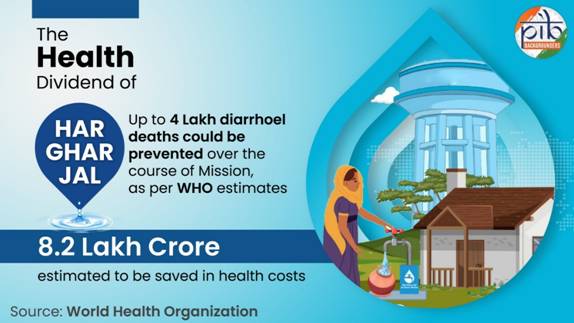
Community-Led and Technology-Driven Success Stories
Prime Minister Narendra Modi has stated, “Jal Jeevan Mission has become a major development parameter to provide water to every household.” The success of the Jal Jeevan Mission (JJM) lies not only in infrastructure creation but also in the spirit of “Jan Bhagidari se Peyjal Prabandhan”, community-led water governance combined with innovative use of technology.
- Women’s Leadership in Water Management – Maharashtra
In Mhapan village, the Amritnath Mahila Samuha, a women’s self-help group, manages the village tap water scheme. Their responsibilities include operating the pump, maintaining the system, taking meter readings, collecting water bills, and resolving complaints. The group achieved 100% water bill collection, stabilising the scheme’s finances and making it self-sustaining. Through efficient management, the SHG earned ₹1,70,000, transforming the group into a sustainable income-generating unit and a model for community-led utility management.
- Source Sustainability and Climate Resilience – Nagaland
In Wokha, Nagaland, people are protecting their water sources under the Jal Jeevan Mission. Communities follow a “people-first, source-first” approach. Communities in Wokha have realised that protecting catchments is the key to protecting their taps and getting free flow of water for years. With support from JJM and in convergence with the Forest and Soil & Water Conservation Departments, villagers are working hand in hand to revive degraded slopes. They have built trenches, recharge pits, and percolation tanks to stop soil erosion and help rainwater seep into the ground. Local trees like alder, oak, and bamboo are planted to hold the soil. Women’s groups lead these plantation drives, while youth clubs take care of the recharge structures.
- Health and Hygiene Transformation – Assam
In Borbori village, Assam, community sensitisation under Jal Jeevan Mission (JJM) helped eliminate long-standing waterborne illnesses. Reported cases dropped from 27 in 2022–23 to zero within two years, with no deaths reported, after the introduction of piped water and hygiene awareness campaigns. Local leader Bindu Devi not only donated her land for the water supply scheme but also promoted a sustainable maintenance model, where each household contributes ₹1 per day to keep the water system functioning smoothly. This approach fostered community ownership and responsibility, ensuring the system’s smooth and long-term operation.
- Converting Water Scarcity to Water Security – Rajasthan
In Bothara village, a community meeting revealed severe water scarcity and groundwater exploitation exceeding 103%. This realisation led to the preparation of a Water Security Plan with a focus on ensuring sustainable drinking water for all households under Jal Jeevan Mission (JJM). During a Water Security Committee (WSC)meeting, villagers raised concerns that the new open well built under JJM needed support of effective recharge measures. Without these, the well could still run dry. The WSC prepared a Water Security Plan and adopted a ridge-to-valley approach. Check dams and contour trenches were built, leading to a 70-foot rise in the water level of an open well within ten days of the check dam’s completion. The effort increased the village’s annual water storage capacity by 11.77%, with the community contributing 5% of the total cost for recharge structures.
- Digital Governance and Transparency – West Bengal
West Bengal’s ‘Jal Mitra’ application revolutionized monitoring and transparency in community water governance. The 'Jal Mitra' Mobile and Web Application is a Management Information System (MIS) aligned with the Jal Jeevan Mission (JJM), which aims to ensure Functional Household Tap Connections (FHTCs) to every rural household, while emphasizing sustained service delivery, community ownership, and participatory monitoring through digital innovation. The digital Management Information System (MIS) platform tracked 13.70 crore community activities (April 2024–August 2025), facilitated functionality assessments for 80.39 lakh households across 22,111 villages, and supported the creation of 4,522 Jal Bachao Committees. The app replaced a fragmented manual process with a real-time, data-driven system, ensuring accountability and sustained functionality.
Conclusion
The Jal Jeevan Mission is transforming rural India by ensuring access to safe tap water for over 81% of households. In just six years, it is turning the vision of Har Ghar Jal into reality through rapid expansion, digital innovation, and strong community involvement. Beyond infrastructure, JJM is improving health, livelihoods, and dignity in villages. It is creating jobs, saving time for women, and reducing waterborne diseases. With sustainability and equity at its core, the Mission stands as a model of good governance and people-led development, taking India closer to universal and reliable water security.
References
Ministry of Jal Shakti
PIB backgrounders
See in PDF
***
SK/SM
(Backgrounder ID: 155710)
Visitor Counter : 98
Provide suggestions / comments